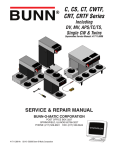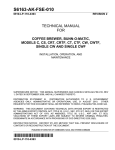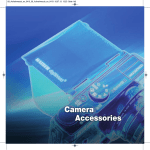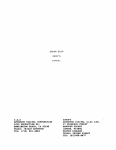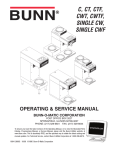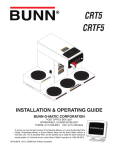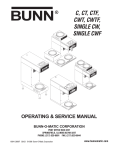Download Bunn CRT5 Repair manual
Transcript
CRT5 CRTF5 SERVICE & REPAIR MANUAL BUNN-O-MATIC CORPORATION POST OFFICE BOX 3227 SPRINGFIELD, ILLINOIS 62708-3227 PHONE: (217) 529-6601 FAX: (217) 529-6644 41711.0000A 11/08 ©2008 Bunn-O-Matic Corporation BUNN-O-MATIC COMMERCIAL PRODUCT WARRANTY Bunn-O-Matic Corp. (“BUNN”) warrants equipment manufactured by it as follows: 1) All equipment other than as specified below: 2 years parts and 1 year labor. 2) Electronic circuit and/or control boards: parts and labor for 3 years. 3) Compressors on refrigeration equipment: 5 years parts and 1 year labor. 4) Grinding burrs on coffee grinding equipment to grind coffee to meet original factory screen sieve analysis: parts and labor for 3 years or 30,000 pounds of coffee, whichever comes first. These warranty periods run from the date of installation BUNN warrants that the equipment manufactured by it will be commercially free of defects in material and workmanship existing at the time of manufacture and appearing within the applicable warranty period. This warranty does not apply to any equipment, component or part that was not manufactured by BUNN or that, in BUNN’s judgment, has been affected by misuse, neglect, alteration, improper installation or operation, improper maintenance or repair, damage or casualty. This warranty is conditioned on the Buyer 1) giving BUNN prompt notice of any claim to be made under this warranty by telephone at (217) 529-6601 or by writing to Post Office Box 3227, Springfield, Illinois 62708-3227; 2) if requested by BUNN, shipping the defective equipment prepaid to an authorized BUNN service location; and 3) receiving prior authorization from BUNN that the defective equipment is under warranty. THE FOREGOING WARRANTY IS EXCLUSIVE AND IS IN LIEU OF ANY OTHER WARRANTY, WRITTEN OR ORAL, EXPRESS OR IMPLIED, INCLUDING, BUT NOT LIMITED TO, ANY IMPLIED WARRANTY OF EITHER MERCHANTABILITY OR FITNESS FOR A PARTICULAR PURPOSE. The agents, dealers or employees of BUNN are not authorized to make modifications to this warranty or to make additional warranties that are binding on BUNN. Accordingly, statements by such individuals, whether oral or written, do not constitute warranties and should not be relied upon. If BUNN determines in its sole discretion that the equipment does not conform to the warranty, BUNN, at its exclusive option while the equipment is under warranty, shall either 1) provide at no charge replacement parts and/or labor (during the applicable parts and labor warranty periods specified above) to repair the defective components, provided that this repair is done by a BUNN Authorized Service Representative; or 2) shall replace the equipment or refund the purchase price for the equipment. THE BUYER’S REMEDY AGAINST BUNN FOR THE BREACH OF ANY OBLIGATION ARISING OUT OF THE SALE OF THIS EQUIPMENT, WHETHER DERIVED FROM WARRANTY OR OTHERWISE, SHALL BE LIMITED, AT BUNN’S SOLE OPTION AS SPECIFIED HEREIN, TO REPAIR, REPLACEMENT OR REFUND. In no event shall BUNN be liable for any other damage or loss, including, but not limited to, lost profits, lost sales, loss of use of equipment, claims of Buyer’s customers, cost of capital, cost of down time, cost of substitute equipment, facilities or services, or any other special, incidental or consequential damages. BrewWISE, BrewLOGIC, BrewWIZARD, BUNN Gourmet Ice, BUNN Pour-O-Matic, BUNN, Bunn-OMatic, Bunn-OMatic, BUNNlink, BUNNserve, BUNN Espress, DBC, Dr. Brew, Dual, EasyClear, EasyGard, Easy Pour, FlavorGard, Gourmet Ice, Gourmet Juice, High Intensity, IMIX, Infusion Series, Quality Beverage Equipment Worldwide, The Mark of Quality in Beverage Equipment Worldwide, My Café, PowerLogic, Safety-Fresh, Scale-Pro, Single, Smart Funnel, Smart Hopper, SmartWAVE, Soft Heat, SplashGard, System III, ThermoFresh, 392, AutoPOD, AXIOM, Beverage Profit Calculator, Beverage Bar Creator, BrewMETER, BUNNSERVE, BUNNsource, Coffee At Its Best, Cool Froth, Digital Brewer Control, Intellisteam, Nothing Brews Like a BUNN, Pouring Profits, Pulse Wave, Signature Series, Silver Series, Smart Heat, Tea At Its Best, The Horizontal Red Line, Titan, Ultra, are either trademarks or registered trademarks of Bunn-O-Matic Corporation. Page 2 41711 100908 Contents Control Thermostat......................................................................................................... 10 Limit Thermostat............................................................................................................. 12 ON/OFF Switch................................................................................................................ 13 Solenoid (Inlet)............................................................................................................... 14 Start Switch (Brew)......................................................................................................... 15 Tank Heater..................................................................................................................... 16 Tank Heater Switch......................................................................................................... 18 Thermal Cut-Off.............................................................................................................. 20 Timer (Early Model)........................................................................................................ 21 Digital Brew Timer (Late Model)..................................................................................... 23 Warmer Element............................................................................................................. 25 Schematic Wiring Diagrams........................................................................................... 26 Page 3 41711 110608 TROUBLESHOOTING A troubleshooting guide is provided to suggest probable causes and remedies for the most likely problems encountered. If the problem remains after exhausting the troubleshooting steps, contact the Bunn-O-Matic Technical Service Department. • Inspection, testing, and repair of electrical equipment should be performed only by qualified service personnel. • All electronic components have 120 volt ac and low voltage dc potential on their terminals. Shorting of terminals or the application of external voltages may result in board failure. • Intermittent operation of electronic circuit boards is unlikely. Board failure will normally be permanent. If an intermittent condition is encountered, the cause will likely be a switch contact or a loose connection at a terminal or crimp. • Solenoid removal requires interrupting the water supply to the valve. Damage may result if solenoids are energized for more than ten minutes without a supply of water. • The use of two wrenches is recommended whenever plumbing fittings are tightened or loosened. This will help to avoid twists and kinks in the tubing. • Make certain that all plumbing connections are sealed and electrical connections tight and isolated. • This brewer is heated at all times. Keep away from combustibles. WARNING – • • • • Exercise extreme caution when servicing electrical equipment. Unplug the brewer when servicing, except when electrical tests are specified. Follow recommended service procedures Replace all protective shields or safety notices PROBLEM PROBABLE CAUSE REMEDY Brew cycle will not start 1. No water Water lines and valves to the brewer must be open. 2. No power or incorrect voltage to the brewer (A1) Check the terminal block for 120 volts across the black and white terminals on two wire 120 volt brewers. (A2) Check the terminal block for 120 volts across the red and white terminals and the black and white terminal on three wire 120/240 volt brewers. (A3) Check the terminal block for 200 volts on "B Series" brewers or 240 volts on "A Series" brewers across the red and black terminals. (B) Check circuit breakers or fuses. Page 4 41711 110608 TROUBLESHOOTING (cont.) PROBLEM Brew cycle will not start (cont.) PROBABLE CAUSE 3. ON/OFF Switch REMEDY Refer to Service - ON/OFF Switch for testing. 4. Start Switch Refer to Service - Start Switch for testing procedures. 5. Timer Refer to Service - Timer for testing procedures. 6. Solenoid Valve Refer to Service - Solenoid Valve for testing procedures. 7. Water strainer/flow control (.222 GPM) (A) Direction of flow arrow must be pointing towards brewer. (B) Remove the strainer/flow control and check for obstructions. Clear or replace. Water is not hot 1. Tank Heater Switch Refer to Service - Tank Heater Switch for testing procedures. 2. (A) Limit Thermostat (B) Thermal Cut-Off (Brewers with Faucet) CAUTION - Do not eliminate or bypass limit thermostat or thermal cut-off. Use only BOM replacement parts. Refer to Service - Limit Thermostat for testing procedures. Thermal Cut-Off for testing procedures. 3. Control Thermostat Refer to Service - Control Thermostat for testing procedures. 4. Tank Heater Refer to Service - Tank Heater for testing procedures. Page 5 41711 110608 TROUBLESHOOTING (cont.) PROBLEM PROBABLE CAUSE REMEDY Inconsistent beverage level in dispenser 1. Strainer /flow control (.222 GPM) (A) Direction of flow arrow must be pointing towards the brewer. (B) Remove the strainer/flow control and check for obstruction. Clear or replace. Consistently low beverage level in the dispenser 2. Syphon System The brewer must be level or slightly lower in front to syphon properly. 3. Lime Build-up CAUTION - Tank and tank components should be delimed regularly depending on local water conditions. Excessive mineral build-up on stainless steel surfaces can initiate corrosive reactions resulting in serious leaks. Inspect the tank assembly for excessive lime deposits. Delime as required. 4. Water Pressure The water pressure to the brewer must be at least 20 psi (138 kPa). 1. Timer Timer dial must indicate at least two minutes and fifteen seconds. 2. Strainer/flow Control (.222 GPM) (A) Direction of flow arrow must be pointing towards brewer. (B) Remove the strainer/flow control and check for obstructions. Clear or replace. Spitting or excessive steaming 1. Lime Build-up CAUTION - Tank and tank components should be delimed regularly depending on local water conditions. Excessive mineral build-up on stainless steel surfaces can initiate corrosive reactions resulting in serious leaks. Page 6 Inspect tank assembly for excessive lime deposits. Delime as required. 41711 110608 TROUBLESHOOTING (cont.) PROBLEM PROBABLE CAUSE REMEDY Spitting or excessive steaming (cont.) 2. Control Thermostat Refer to Service - Control Thermostat for testing procedures. Dripping from sprayhead 1. Syphon System The brewer must be level or slightly lower in front to syphon properly. 2. Lime Build-up CAUTION - Tank and tank components should be delimed regularly depending on local water conditions. Excessive mineral build-up on stainless steel surfaces can initiate corrosive reactions resulting in serious leaks. Inspect the tank assembly for excessive lime deposits. Delime as required. 3. Solenoid Valve Remove the solenoid valve and clear any obstructions. Rebuild or replace the valve if necessary. Water flows into tank continuously (ON/OFF Switch "ON") 1. Timer Refer to Service - Timer for testing procedures. Water flows into tank continuously (ON/OFF Switch "OFF") 1. Solenoid Valve Remove the Solenoid Valve and clean any obstruction. Rebuild or replace the valve if necessary. Beverage overflows dispenser 1.Dispenser The dispenser must be completely empty before starting a brew cycle. 2. Timer Refer to Service - Timer for testing procedures. 3. Solenoid Valve Remove the Solenoid Valve and clean any obstruction. Rebuild or replace the valve if necessary. Page 7 41711 110608 TROUBLESHOOTING (cont.) PROBLEM PROBABLE CAUSE REMEDY Weak beverage 1. Filter Type BUNN® paper filters must be used for proper extraction. 2. Coffee Grind A fine or drip grind must be used for proper extraction. 3. Sprayhead A six-hole stainless steel sprayhead must be used for proper extraction. 4. Funnel Loading The BUNN® paper filter must be centered in the funnel and the bed of ground leveled by gentle shaking. 5. Water Temperature Place an empty funnel on an empty dispenser beneath the sprayhead. Initiate a brew cycle and check the water temperature immediately below the sprayhead with a thermometer. The reading should not be less than 195°F (76°C). Adjust the control thermostat to increase the water temperature. Replace if necessary. Dry coffee grounds remain in the funnel 1. Funnel Loading The BUNN® paper filter must be centered in the funnel and the bed of grounds leveled by gently shaking. Brewer is making unusal noises 1. Solenoid The nut on the solenoid must be tight or it will vibrate during operation. 2. Plumbing Lines Plumbing lines should not resting on the counter top. 3. Water Supply (A) The brewer must be connected to a cold water line. (B) Water pressure to the brewer must not exceed 90 psi (620 kPa). Install a regulator if necessary to lower the working pressure to approximately 50 psi (345 kPa). Page 8 41711 110608 TROUBLESHOOTING (cont.) PROBLEM PROBABLE CAUSE REMEDY Brewer is making unusal noises (cont.) 4. Tank Heater Remove and clean lime off the tank heater. Low beverage serving temperature 1. Warmer Refer to Service - Warmer element for testing procedures. 2. ON/OFF Switch Refer to Service - ON/OFF Switch for testing procedures. Page 9 41711 110608 SERVICE This section provides procedures for testing and replacing various major components used in this brewer should service become necessary. Refer to Troubleshooting for assistance in determining the cause of any problem. CONTROL THERMOSTAT WARNING - Inspection, testing, and repair of electrical equipment should be performed only by qualified service personnel. The brewer should be unplugged when servicing, except when electrical tests are required and the test procedure specifically states to plug-in the brewer. COMPONENT ACCESS WARNING - Disconnect the brewer from the power source before the removal of any panel or the replacement of any component. All components are accessible by the removal of the top cover, front inspection panel and warmer plate(s). The top cover is attached with one #4-40 screw. The front inspection panel is attached with four #6-32 screws. The warmer assembly is attached with three #4-40 screws. FIG. 2 CONTROL THERMOSTAT P2186.40 Location: The control thermostat is located inside the trunk on the upper left side of the component bracket. Test Procedures: 1. Disconnect the brewer from the power source. 2. Locate the blue wire on the control thermostat. 3. Check the voltage across the blue wire on the control thermostat and the white insert on two pole 120 volt terminal block or three pole 120/240 volt terminal blocks and the red insert on two wire 200 volt or 240 volt terminal block with a voltmeter. Connect the brewer to the power source. The indication must be: a) 120 volts ac for two wire 120 volt models and three wire 120/240 volt models. b) 200 to 240 volts ac for two wire 200 or 240 volt models. 4. Disconnect the brewer from the power source. If voltage is present as described, proceed to #5. If voltage is not present as described, refer to the wiring diagrams and check the brewer wiring harness. FIG. 1 COMPONENT ACCESS P939 5. 6. 7. Page 10 Locate the black wire on the control thermostat. Gently remove the capillary bulb and grommet from the tank. Check the voltage across the black wire of the 41711 110608 SERVICE (cont.) CONTROL THERMOSTAT (cont.) control thermostat and the white insert on the two pole 120 volt or three pole 120/240 volt terminal block and the red insert on the two pole 200 volt or 240 volt terminal block with a voltmeter when the control thermostat is turned fully clockwise. Connect the brewer to the power source. The indication must be: a) 120 volts ac for two wire 120 volt models and three wire 120/240 volt models. b) 200 to 240 volts ac for two wire 200 volt or 240 volt models. 8. Disconnect the brewer from the power source. 8. For first type thermostat, refer to the Fig. 3 when reconnecting thermostat wires. For second type thermostat, it does not matter which lead is connected to which terminal. 9. Adjust the control thermostat as required. If voltage is present as described, reinstall the capillary tube into the tank to the line 4.5" above the bulb, the control thermostat is operating properly. If voltage is not present as described, replace the thermostat. Removal and Replacement: 1. Disconnect the control thermostat wires. 2. Remove the thermostat capillary bulb by firmly pulling-up on the capillary at the tank lid. This will disengage the grommet from the tank lid. 3. Remove the one #8-32 screw securing the control thermostat to the component bracket inside the trunk. 4. Slide the grommet to the line 4.5" above the bulb on the new capillary tube. 5. Insert the capillary bulb through the hole in the tank lid and press the grommet firmly and evenly so that the groove in the grommet fits into the tank lid. 6. Carefully bend the capillary tube so that the tube and bulb inside the tank are in the vertical position. BLU to BLU wire from Limit Thermostat BLK to BLK Wire from Tank Heater (Brewers w/out Faucet) BLK to Thermal Cut-Off from Tank Heater (Brewers with Faucet) First Type Thermostat Second Type Thermostat P1129 FIG. 3 CONTROL THERMOSTAT TERMINALS NOTE - The capillary tube must be clear of any electrical termination and not kinked. 7. Using one #8-32 screw, secure the control thermostat to the component bracket inside the trunk. Page 11 41711 110608 SERVICE (cont.) LIMIT THERMOSTAT If continuity is present as described, the limit thermostat is operating properly. If continuity is not present as described, replace the limit thermostat. Removal and Replacement: 1. Remove all wires from limit thermostat terminals. 2. Carefully slide the limit thermostat out from under the retaining clip and remove limit thermostat. 3. Carefully slide the new limit thermostat into the retaining clip. 4. Refer to the Fig. 5 when reconnecting the wires. BLK to Tank Heater Switch FIG. 4 LIMIT THERMOSTAT BLU to BLU Lead from Control Thermostat P2186.40 Location: The limit thermostat is located inside the rear of the hood on the tank lid. Test Procedures: 1. Disconnect the brewer from the power source. 2. Disconnect the blue and black wires from the limit thermostat. 3. Check for continuity across the limit thermostat terminals with a ohmmeter. Page 12 P1800 FIG. 5 LIMIT THERMOSTAT TERMINALS 41711 110608 SERVICE (cont.) ON/OFF WARMER SWITCH switch. Removal and Replacement: 1. Remove the wires from the switch terminals. 2. Compress the clips inside the hood and gently push the switch through the opening. 3. Push the new switch into the opening and spread the clips to hold switch in the hood. 4. Refer to Fig.7 when reconnecting the wires. FIG. 6 ON/OFF WARMER SWITCHES P939 Location: The ON/OFF switch(s) are located on the front of the hood. Test Procedure: 1. Disconnect the brewer from the power source. 2. Viewing the switch from the back remove the white or red wire from the upper terminal and the black wire from the center terminal. 3. Check the voltage across the white wire or red wire and the black wire with a voltmeter. Connect the brewer to the power source. The indication must be: a) 120 volts ac for two wire 120 volt models and three wire 120/240 volt models. b) 200 to 240 volts ac for two wire 200 or 240 volt models.4. Disconnect the brewer from the power source. If voltage is present as described, reconnect the white or red wire and proceed to #5. If voltage is not present as described, refer to the Wiring Diagrams and check the brewer wiring harness. 5. With the black wire removed, remove the wire from the lower terminal. 6. Check for continuity across the center and lower terminal with the switch in the "ON" position. Continuity must not be present when the switch is in the "OFF" position. If continuity is present as described, reconnect the black wire to the center terminal and the remaining wire to the lower terminal. If continuity is not present as described, replace the WHI to Terminal Block (White Insert on 120V or 120/240V Models) RED to Terminal Block (Red Insert on 200V or 240V) BLK to Terminal Block (Black Insert) WHI/RED to Lower Center Warmer LOWER CENTER WARMER WHI to Terminal Block (White Insert on 120V or 120/240V Models) RED to Terminal Block (Red Insert on 200V or 240V BLK to Terminal Block (Black Insert) YEL to Left Front Warmer LEFT FRONT WARMER WHI to Terminal Block (White Insert on 120V or 120/240V Models) RED to Terminal Block (Red Insert on 200V or 240V) BLK to Terminal Block (Black Insert) WHI/VIO to Left Rear Warmer LEFT REAR WARMER WHI to Terminal Block (White Insert on 120V or 120/240V Models) RED to Terminal Block (Red Insert on 200V or 240V BLK to Terminal Block (Black Insert) BRN/BLK to Right Front Warmer RIGHT FRONT WARMER WHI to Terminal Block (White Insert on 120V or 120/240V Models) RED to Terminal Block (Red Insert on 200V or 240V) BLK to Terminal Block (Black Insert) VIO to Right Rear Warmer RIGHT REAR WARMER P1257.50 Page 13 FIG. 7 ON/OFF WARMER SWITCH TERMINALS 41711 110608 SERVICE (cont.) SOLENOID VALVE 6. Check the solenoid valve for coil action. Connect the brewer to the power source. With "ON/OFF" switch in the "ON' upper position press start switch and listen carefully in the vicinity of the solenoid valve for a" clicking" sound as the coil magnet attracts. 7. Disconnect the brewer from the power source. If the sound is heard as described and water will not pass through the solenoid valve, there may be a blockage in the water line before the solenoid valve or, the solenoid valve may require inspection for wear, and removal of waterborne particles. If the sound is not heard as described, replace the solenoid valve. FIG. 8 SOLENOID VALVE P2186.45 Location: The solenoid valve is located inside the trunk on the lower center part of the component bracket. Test Procedures: 1. Disconnect the brewer from the power source. 2. Disconnect the white and black wires from the solenoid valve. With the "ON/OFF" switch in the "ON" upper position press the start switch. 3. Check the voltage across the white and black wires with a voltmeter. Connect the brewer to the power source. The indication must be: a) 120 volts ac for two wire 120 volt models and three wire 120/240 volt models. b) 200 to 240 volts ac for two wire 200 or 240 volt models. 4. Disconnect the brewer from the power source, If voltage is present as described, proceed to #5 If voltage is not present as described, refer to Wiring Diagrams and check brewer wiring harness. Removal and Replacement: 1. Remove the white and black from the solenoid valve. 2. Turn off the water supply to the brewer. 3. Disconnect the water lines to and from the solenoid valve. 4. Remove the two #8-32 screws securing the solenoid mounting bracket to the component bracket. Remove solenoid bracket and solenoid valve as an assembly. 5. Remove the two #10-32 screws and lockwashers securing the solenoid valve to the solenoid bracket. 6. Using two #10-32 screws and lockwashers install new solenoid valve on solenoid mounting bracket. 7. Using two #8-32 screws install solenoid valve and bracket to the component bracket. 8. Securely fasten the water lines to and from the solenoid valve. 9. Refer to Fig. 9 when reconnecting the wires. WHI from Timer BLK from Timer 5. Check for continuity across the solenoid valve coil terminals. If continuity is present as described, reconnect the white and black wire from the timer. If continuity is not present as described, replace the solenoid valve. Page 14 P1132.40 FIG. 9 SOLENOID VALVE TERMINALS 41711 110608 SERVICE (cont.) START SWITCH BREWERS W/FRESH LIGHT If continuity is present as described, reconnect the blue wire and the white/red to the switch terminals. If continuity is not present as described, replace the switch. Removal and Replacement: 1. Remove the blue wire and white/red from the start switch. 2. Remove round retaining nut from the front of the switch and remove switch and internal tooth lockwasher from the inside of the hood. 3. Push new switch with internal tooth lockwasher through the hole in the hood and secure with round retaining nut. 4. Refer to Fig. 11 when reconnecting the wires. P1258.50 WHI/RED to Timer P3 FIG. 10 START SWITCH P939 BLU to Timer P1 FIG. 11 START SWITCH TERMINALS P1259 Location: On brewers w/out fresh light the start switch is located in the right front of the hood. On brewers w/fresh light the start switch is located on the right side of the hood. Test Procedure: 1. Disconnect the brewer from the power supply. 2. Disconnect the blue wire and the white/red wire from the switch terminals. 3. Check for continuity across the two terminals on the switch when it is held in the "pressed-in" position. Continuity must not be present across these terminals in the released position. Page 15 41711 110608 SERVICE (cont.) HEATER 1800W-120V 1850W-220V TANK HEATER 3500W-200V 3500W-240V RESISTANCE 7.40 - 8.70 24.40 -28.40 10.70 15.36 -12.36 -17.90 TERMINAL TO SHEATH - INFINITE (OPEN) If resistance is present as described, reconnect the wires, the tank heater is ok. If resistance is not present as described, replace the tank heater. NOTE- If any resistance is read between sheath and either terminal, remove and inspect heater for cracks in the sheath. FIG. 12 TANK HEATER P2186.45 Location: The tank heater is located inside the tank and secured to the tank lid. Test Procedures: 1. Disconnect the brewer from the power supply. 2. Check the voltage across the black and white wires on 120 volt models or the black and red wires for 120/240 volt models, 200 volt models and 240 volt models with a voltmeter. Connect the brewer to the power source. The indication must be: a) 120 volts ac for two wire 120 volt 20 amp models . b) 240 volts ac for three wire 120/240 volt models. c) 200 to 240 volts ac for two wire 200 or 240 volt models. 3. Disconnect the brewer from the power source. If voltage is present as described, proceed to #4 If voltage is not present as described, refer to the Wiring Diagrams and check wiring harness. 4. Disconnect the wires from the tank heater terminals. 5. Check resistance value across tank heater terminals and compare to chart. Removal and Replacement: 1. Disconnect the water supply tube from the fill basin. 2. Remove the tank inlet fitting securing the fill basin to the tank lid, remove fill basin and tank inlet gasket. Set all three parts aside for reassembly. 3. On brewers with faucet shut-off water supply to the brewer and disconnect the inlet and outlet water lines to the faucet coil assembly. 4. Disconnect the black wire on the limit thermostat from the tank heater switch. On late model brewers also disconnect the blue wire from the limit thermostat to the control thermostat. 5. Disconnect the black wire and the white or red wire from the tank heater terminals. 6. Remove sprayhead and the hex nut securing the sprayhead tube to the hood. Set aside for reassembly. 7. Remove the eight #8-32 nuts securing the tank lid to the tank. 8. Remove the tank lid with limit thermostat, sprayhead tube, tank heater, coil assembly and control thermostat w/bracket (early models only). 9 Remove the two hex nuts securing the tank heater to the tank lid. Remove tank heater with gaskets and discard. 10.Install new tank heater with gaskets on the tank lid and secure with two hex nuts. 11.Install tank lid with limit thermostat, sprayhead tube, tank heater, coil assembly (brewers with faucet) and control thermostat with bracket (early Page 16 41711 110608 SERVICE (cont.) TANK HEATER (Cont.) brewers only) using eight #8-32 hex nut. 12.Reconnect the inlet and outlet water lines to the faucet coil assembly. 13.Secure sprayhead tube to hood using a hex nut. 14. Install sprayhead. 15. Reconnect the wires to the limit thermostat, tank heater and control thermostat. See limit thermostat and control thermostat sections in this manual when reconnecting wires. 16.Install fill basin, secure with tank inlet fitting and gasket. Insert water supply line through grommet in fill basin. 17. Refer to Fig.13 when reconnecting the tank heater wires. WHI to Terminal Block (White Insert on 230V Two Wire Models) RED to Terminal Block (Red Insert on 120/240V Three Wire Models or 200V and 240V Two Wire Models BLK to Control Thermostat (Brewers W/ Out Faucet) Thermal Cut-Off to BLK from Control Thermostat (Brewers W/ Faucet) FIG. 13 TANK HEATER TERMINALS P1168.71 Page 17 41711 110608 SERVICE (cont.) TANK HEATER SWITCH 5. With the tank heater switch in the "ON" upper position, check for continuity between the black wire removed from the limit thermostat and the black insert on the terminal block. Continuity should not be present in the "OFF" lower position. If continuity is present as described, the tank heater switch is operating properly. If continuity is not present as described, replace the tank heater switch. FIG 14 TANK HEATER SWITCH P2186.45 Location: The tank heater switch is located on the rear of the brewer on the upper left side of the trunk. Test Procedure: 1. Disconnect the brewer from the power source. 2. Disconnect the black wire from the limit thermostat. 3. With the tank heater switch in the "ON" position and with a voltmeter, check the voltage between the black wire removed from the limit thermostat and the white wire or red wire on the tank heater. Connect the brewer to the power source. The indication must be: a) 120 volts ac on two wire 120 volt models. b) 240 volts ac on three wire 120/240 volt models. c) 200 to 240 volts ac on 200 volt or 240 volt models. 4. Disconnect the brewer from the power source. If voltage is not present as described, proceed to #5. If voltage is present as described, the switch is working properly. Removal and Replacement: 1. Shut off and disconnect the incoming water supply to the brewer. 2. On automatic brewers gently remove the fill tube from back of fill basin. 3. Remove the tank inlet fitting securing fill basin the tank lid. Remove fill basin and gasket. Set all three parts aside for reassembly. 4. On brewers with faucets, disconnect the water supply to coil assembly and remove the tube from the tank to the faucet. 5. Remove sprayhead and hex nut securing sprayhead tube to the hood. Set aside for reassembly. 6. Disconnect the wires on the limit thermostat and the tank heater and the control thermostat (early models). 7. Gently pull the thermostat sensor and grommet from the tank lid. 8. Insert a tube to the bottom of the tank and syphon ALL of the water out. 9. Remove the two #8-32 screws securing the tank assembly to the hood. 10.Lift tank and components out as an assembly and set aside for reassembly. 11.Disconnect the two black wires from the tank heater switch. 12.Remove the plastic facenut, hex facenut and the switch indicator/guard bracket that secures tank heater switch to the rear of the brewer. Remove switch and discard. 13.Insert new tank heater switch through the hole in the upper left rear of the trunk and secure with switch indicator/guard bracket, hex facenut and plastic facenut. 14.Reconnect the two black wires to the tank heater switch terminals. Page 18 41711 110608 SERVICE (cont.) TANK HEATER SWITCH (cont.) 15.Set tank assembly inside the hood on mounting brackets and secure with two #8-32 screws. 16.Reconnect the wires to the limit thermostat, tank heater and the control thermostat. Refer to limit thermostat, tank heater and control thermostat sections in this manual when reconnecting wires. 17.Brewers with faucet reinstall the faucet tube and reconnect the water supply tube to the coil assembly. 18.Secure the sprayhead tube to the hood using hex nut. 19.Install sprayhead. 20.Install fill basin, inlet gasket and secure to tank lid with tank inlet fitting. 21.Carefully install water fill tube into the back of the fill basin. 22.Reconnect and turn on the incoming water supply. 23.Refer to Fig. 15 when reconnecting the wires. BLK to Limit Thermostat BLK to Terminal Block (Black Insert) P1135.80 FIG. 15 TANK HEATER SWITCH TERMINALS Page 19 41711 110608 SERVICE (cont.) THERMAL CUT-OFF (Brewers W/Faucet) If continuity is present as described, the thermal cutoff is operating properly. If continuity is not present as described, replace the thermal cut-off. Removal and Replacement: 1. Disconnect the thermal cut-off from the tank heater and the black lead from the control thermostat. 2. Install new thermal cut-off. 3. Refer to Fig. 17 when reconnecting wires. Fig. 16 THERMAL CUT-OFF P2186.40 Location: The thermal cut-off is located inside the hood connected to the tank heater. Test Procedures: 1. Disconnect the brewer from the power source. 2. Disconnect the thermal cut-off from the tank heater and the black wire from the control thermostat. 3. Check for continuity across thermal cut-off terminals with an ohmmeter. Page 20 WHI or RED to Terminal Block Thermal Cut-Off from Tank Heater to BLK Lead from Control Thermostat P1275.70 FIG. 17 THERMAL CUT-OFF TERMINALS 41711 110608 SERVICE (cont.) If voltage is present as described, proceed to #5. If voltage is not present as described, refer to the Wiring Diagrams and check the brewer wiring harness. TIMER (Early Models) 5. Check the voltage across the sockets P1 & P2 (blue and white wires) of the female connector with a voltmeter when the "ON/OFF" switch is in the "ON" position (upper) and start switch pressed. Connect the brewer to the power source. The indication must be: a) 120 volts ac for two wire 120 volt models and three wire 120/240 volt models. b) 200 to 240 volts ac for two wire 200 volt or 240 volt models. 6. Disconnect the brewer from the power source. 7. Reconnect the three pin connector from main wiring harness to the timer. FIG. 18 TIMER P1256.45 Location: The timer is located inside the front of the trunk on the upper right side of component bracket. Test Procedure. 1. Disconnect the brewer from the power source. 2. Disconnect the polarized, three pin connector from the brewer wiring harness and rotate the brew timer dial fully counterclockwise. 3. With a voltmeter, check the voltage across sockets P2 & P3 (white and white/red wires) of the female connector when the "ON/OFF" switch is in the "ON" position (upper). Connect the brewer to the power source. The indication must be: a) 120 volts ac for two wire 120 volt models and three wire 120/240 volt models. b) 200 to 240 volts ac on two wire 200 volt or 240 volt models. 4. Disconnect the brewer from the power source. If voltage is present as described, proceed to #8 If voltage is not present as described, refer to Wiring Diagrams and check the brewer wiring harness. 8. Disconnect the black and white wires from the solenoid. 9. With a voltmeter, check the voltage across the black and white wires when the "ON/OFF" switch is in the "ON" position (upper) and the "START" switch is pressed to the "START" position and released. Connect the brewer to the power source. The indication must be: a) 120 volts ac for approximately 20 seconds for two wire 120 volt models and three wire 120/240 volt models. b) 200 to 240 volts ac for approximately 20 seconds for two wire 200 volt or 240 volt models. If voltage is present as described, the brew timer is operating properly. Reset the timer dial as required, Page 21 41711 110608 SERVICE (cont.) TIMER (cont.) to obtain the desired brew volume. If voltage is not present as described, replace the timer. Removal and Replacement: 1. Separate all connectors between the brewer wiring harness and the timer. 2. Remove the one #8-32 screw securing timer to component bracket. 3 Install new timer circuit board as described in Late Model Timer section on the following pages. 4. Refer to Fig. 21 when reconnecting the wires. 5. Install the Timer Setting decal provided with the replacement timer kit, below the schematic on the inside of the front access panel. 6. Adjust the timer as required. Refer to Late Model Timer section on the following pages. Page 22 To Main Wiring Harness WHI to Solenoid Valve BLK to Solenoid Valve OLD STYLE FIG. 19 TIMER TERMINALS P1136 41711 110608 SERVICE (cont.) DIGITAL BREW TIMER (Late Models) indication must be as follows: a) 120 volts ac for two wire 120 volt models and three wire 120/240 volt models. b) 200 to 240 volts ac for two wire 200 volt or 240 volt models. If voltage is present as described, the timer is operating properly. Reset the timer as required, to obtain the desired brew volume. If voltage is not present as described, proceed to #6. FIG. 20 DIGITAL BREW TIMER P2186.45 Location: The timer is located inside the front of the trunk on the upper right side of component bracket. Test Procedure NOTE: Do not remove or install wires while timer board is installed. Pressure applied to one side may cause damage to the board. 1. Disconnect the brewer from the power source and remove the front access panel. 2. With a voltmeter, check the supply voltage across terminals TL1 and TL2 when the "ON/OFF" switch is in the "ON" position. Connect the brewer to the power source. The indication must be: a) 120 volts ac for two wire 120 volt models and three wire 120/240 volt models. b) 200 to 240 volts ac on two wire 200 volt or 240 volt models. 3. Disconnect the brewer from the power source. If voltage is present as described, proceed to #4. If voltage is not present as described, refer to the Wiring Diagrams and check the wiring harness. 6. With a voltmeter, check the input start voltage across terminals TL2 and TL5 when the "ON/OFF" switch is in the "ON" position. Connect the brewer to the power source and press the "START" switch. The indication must be as follows: a) 120 volts ac for two wire 120 volt models and three wire 120/240 volt models. b) 200 to 240 volts ac on two wire 200 volt or 240 volt models. If voltage is not present as described, refer to the Wiring Diagrams and check the wiring harness to the start switch. If voltage is present as described, disconnect the brewer from the power source and replace the timer. Removal and Replacement: 1. Remove the two #8-32 screws securing circuit board to the mounting bracket. 2. Remove circuit board and spacers (as required). 3. Remove all wires from the timer. 4. Attach all wires to the replacement timer board prior to installation to the component mounting bracket. Refer to FIG. 21 when reconnecting the wires. 5. Install new circuit board with spacers (as required) to the component mounting bracket. 6. Adjust the timer as described in the next section. 4. With a voltmeter, check the output voltage across terminals TL2 and TL4 when the "ON/OFF" switch is in the "ON" position. Connect the brewer to the power source and press the "START" switch. The Page 23 41711 110608 SERVICE (cont.) DIGITAL BREW TIMER (Late Models)(cont.) Timer Setting: NOTE: Prior to setting or modifying volumes, check that the brewer is connected to water supply, the tank is properly filled, and a funnel and server are in place. NOTE: All volume settings must be done with the sprayhead installed. 1. Modifying brew volumes. To modify a brew volume, first check that the SET/LOCK switch is in the “SET” position on the circuit board. To increase a brew volume, place the ON/OFF switch in the “ON” position, press and hold the START switch until three clicks are heard. Release the switch and press it again one or more times. (Failure to release the switch within two seconds after the third click causes the volume setting to be aborted and previous volume setting will remain in memory) Each time the switch is pressed, two seconds are added to the brew time period. Allow the brew cycle to finish in order to verify that the desired volume has been achieved. NOTE: Several ounces of water will continue to syphon from the tank after turning the switch “OFF”. The brewer remembers this volume and will continue to brew batches of this size until the volume setting procedure is repeated. NOTE: When brewing coffee, volume will decrease due to absorption by the coffee grounds. 3. Setting programming disable feature. If it becomes necessary to prevent anyone from changing brew time once programmed, you can set the SET/ LOCK switch to the “LOCK” position. This will prevent any further programming until switch is once again put into the “SET” position. To decrease a brew volume, place the ON/OFF switch in the “ON” position, press and release the START switch once for every two-second interval to be removed from the total brew time period; then immediately press and hold down the START switch until three clicks are heard. Release the switch. (Failure to release the switch within two seconds after the third click causes the volume setting to be aborted and previous volume setting will remain in memory). Allow the brew cycle to finish in order to verify that the desired volume has been achieved. 2. Setting brew volumes. To set a brew volume, first check that the SET/LOCK switch is in the “SET” position on the circuit board. Place the ON/OFF switch in the “ON” position, press and hold the START switch until three distinct clicks are heard and then release the switch. (Failure to release the switch within two seconds after the third click causes the volume setting to be aborted and previous volume setting will remain in memory. View the level of the liquid being dispensed. When the desired level is reached, turn the ON/OFF switch to “OFF”. Page 24 P2037 BLU wire to TL5 from start switch WHI/GRN wire to TL4 from solenoid WHI/BLU wire to TL3 from solenoid WHI wire to TL2 from N/L2 WHI/RED wire to TL1 from on/off switch FIG. 21 DIGITAL TIMER WIRING 41711 110608 SERVICE (cont.) WARMER ELEMENT(S) If resistance is to specification, reconnect the two wires to the warmer element. If resistance is not to specification, replace the warmer element. FIG. 22 WARMER ELEMENTS P939 Location: Removal and Replacement: 1. Remove the three #4-40 screws securing the warmer assembly to the brewer. 2. Lift the warmer assembly from the brewer. 3. Disconnect the two wires from the warmer element terminals. 4. Remove the two #8-32 nuts securing the warmer element to the warmer plate. 5. Securely install new warmer element. 6. Reconnect the two wires to warmer element terminals. 7. Securely install warmer assembly on the brewer. The warmer element(s) is located under the warmer plate. Test Procedures: 1. Disconnect the brewer from the power source. 2. With a voltmeter, check voltage across the two wires at the warmer element with the "ON/OFF" switch in the "ON" position. Connect the brewer to the power source. The indication must be 120 volts ac for two wire 120 volt models and three wire 120/208 and 120/240 volt models, or 230 volts ac for two wire 230 volt models. 3. Disconnect the brewer from the power source. WHI/RED to ON/OFF Switch (Center Warmer) YEL to ON/OFF Switch (Left Front Warmer) WHI/VIO to ON/OFF Switch (Left Rear Warmer) BRN/BLk to ON/OFF Switch (Right Front Warmer) VIO to ON/OFF Switch (Right Rear Warmer) WHI to Terminal Block (120V or 120/240V Brewers) RED to Terminal Block (200V or 240V Brewers If voltage is present as described, proceed to #4. If voltage is not present as described, refer to Wiring Diagrams and check wiring harness. 4. Check the resistance across the two terminals on the warmer element. Refer to the following chart. P1261 FIG. 23 WARMER ELEMENT TERMINALS WARMER RESISTANCE 100W-120V 132 - 152 100W-220V 450 - 532 100W-200V 372 - 432 TERMINAL TO SHEATH - INFINITE (OPEN) Page 25 41711 110608 SCHEMATIC WIRING DIAGRAM CRT5, & CRTF5 L1 HEATER SWITCH BLK LIMIT THERMOSTAT BLK BLU SWITCH AND THERMOSTAT N GREEN (FAUCET OPTION ONLY) THERMAL CUT-OFF TANK HEATER BLK L2 WHI (MODEL 20) RED (MODEL 35) WHI WHI "KEEP WARM" HEATER ON/OFF SWITCH WHI WHI WHI/RED BLK LOWER CENTER WARMER START SWITCH WHI/RED BLU SOL WHI/RED WHI/BLU T1 T5 T3 BREW TIMER ON/OFF SWITCH BLK T4 T2 WHI/GRN WHI WHI YEL LEFT FRONT WARMER ON/OFF SWITCH WHI WHI WHI/VIO BLK LEFT REAR WARMER ON/OFF SWITCH WHI BRN/BLK BLK RIGHT FRONT WARMER ON/OFF SWITCH BLK WHI WHI VIO RIGHT REAR WARMER 120/240 VOLTS AC 3 WIRE 120 VOLTS AC 2 WIRE SINGLE PHASE 10476.0000G 07/03 © 1990 BUNN-O-MATIC CORPORATION White Strip-Tac Page 26 Plus Black Ink 41711 110608 SCHEMATIC WIRING DIAGRAM CRT5A, & CRTF5A L1 L2 GRN/YEL HEATER SWITCH BLK LIMIT THERMOSTAT BLU BLK SWITCH AND THERMOSTAT (MODEL CRTF5A ONLY) THERMAL CUT-OFF BLK TANK HEATER WHI RED WHI "KEEP WARM" HEATER ON/OFF SWITCH RED WHI/RED BLK RED LOWER CENTER WARMER START SWITCH WHI/RED SOL BLU WHI/RED WHI/BLU T1 T5 T3 T4 BREW T2 TIMER ON/OFF SWITCH BLK WHI/GRN RED RED YEL LEFT FRONT WARMER ON/OFF SWITCH RED RED WHI/VIO BLK LEFT REAR WARMER ON/OFF SWITCH BLK RED BRN/BLK RIGHT FRONT WARMER ON/OFF SWITCH BLK RED RED VIO RIGHT REAR WARMER 240 VOLTS AC 2 WIRE SINGLE PHASE 10477.0000H 07/03 © 1990 BUNN-O-MATIC CORPORATION Page 27 41711 110608 SCHEMATIC WIRING DIAGRAM CRT5B, & CRTF5B L1 L2 GREEN HEATER SWITCH BLK LIMIT THERMOSTAT BLU BLK (MODEL CRTF5B ONLY) THERMAL CUT-OFF BLK SWITCH AND THERMOSTAT TANK HEATER ON/OFF SWITCH BLK WHI WHI WHI/RED WHI LOWER CENTER WARMER START SWITCH WHI/RED SOL BLU WHI/RED WHI/BLU T1 T5 T3 T4 BREW T2 TIMER ON/OFF SWITCH WHI/GRN WHI WHI YEL BLK LEFT FRONT WARMER ON/OFF SWITCH BLK WHI WHI WHI/VIO LEFT REAR WARMER ON/OFF SWITCH BLK WHI BRN/BLK RIGHT FRONT WARMER ON/OFF SWITCH BLK WHI WHI VIO RIGHT REAR WARMER 200 VOLTS AC 2 WIRE SINGLE PHASE 10477.0001H 07/03 © 1993 BUNN-O-MATIC CORPORATION Page 28 41711 110608




























